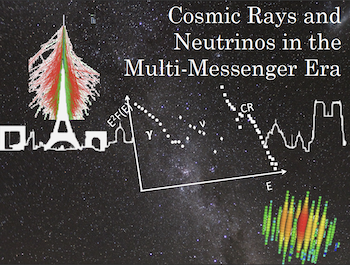Orateur
Description
The advent of gravitational wave and neutrino astronomy has led to an exciting era
of multi-messenger astronomy. Identifying high-energy neutrino emission from
compact binary mergers could shed light on the sources of high-energy neutrino
emission as well as particle acceleration mechanisms in these compact binary
systems. The LIGO-Virgo Collaboration (LVC) has reported a total of 67 compact
binary merger candidates throughout its first three observing runs. We present a
search for high-energy neutrino emission from each merger reported by LVC using
the IceCube neutrino observatory.
In this work we use an unbinned maximum likelihood method to test for spatial
and temporal correlation of IceCube neutrino candidates with the GW candidates
reported by LVC. We test for neutrino correlations within a ±500s time window
centered around the GW merger time. The test statistic is the log-likelihood ratio
weighted by a spatial weight derived from the GW localization uncertainty. A p-
value describing the probability that the neutrinos on the sky are consistent with
the GW source is computed for each GW candidate independently.
Figure 2 shows the final p value distribution for all of the 67 GW candidates we
tested. No statistically significant neutrino correlations are observed and thus we
set upper limits on the time-integrated neutrino flux from each GW candidate as
well as setting limits on the isotropic equivalent energy, E$_\mathrm{iso}$ emitted in high-energy neutrinos.
Figure 3 shows our upper limits on E$_\mathrm{iso}$ as a function of the distance to the GW candidate. We see that the upper limits on E$_\mathrm{iso}$ follow roughly an $r^2$ scaling as expected from geometric arguments.
Note that LVC recently published their second GW catalog, GWTC-2, in which they reported 39 events from the first half of the O3 run. This work does not include the new events reported in this catalog and also contains some events that are no longer considered GW candidates in the new catalog. We are currently working on updating our results using the new catalog. Additional analyses searching for neutrino emission are currently in progress. One analysis searches for neutrino
emission on longer time scales. There are also two analyses searching for neutrino
emission with different data samples, namely cascade type events and lower
energy neutrino events. For more details on this analysis, see the published paper
in ApJL, DOI: 10.3847/2041-8213/ab9d24
| Related session | Multi-messenger |
|---|




